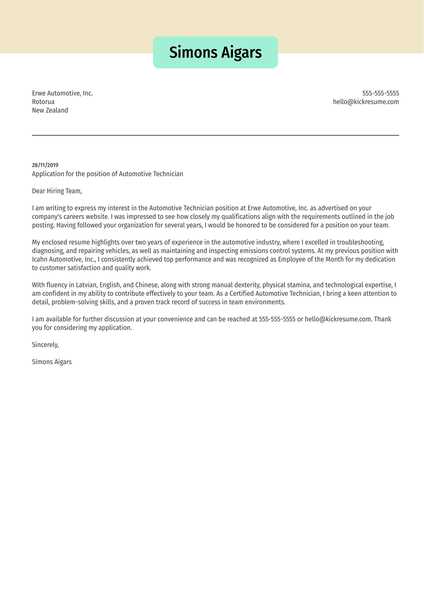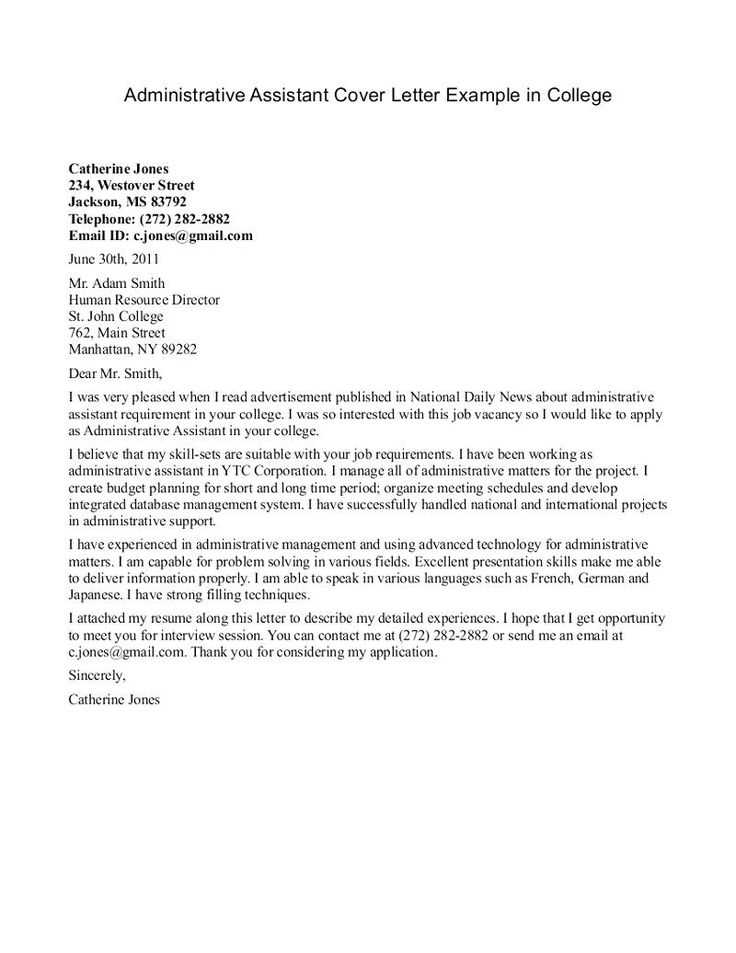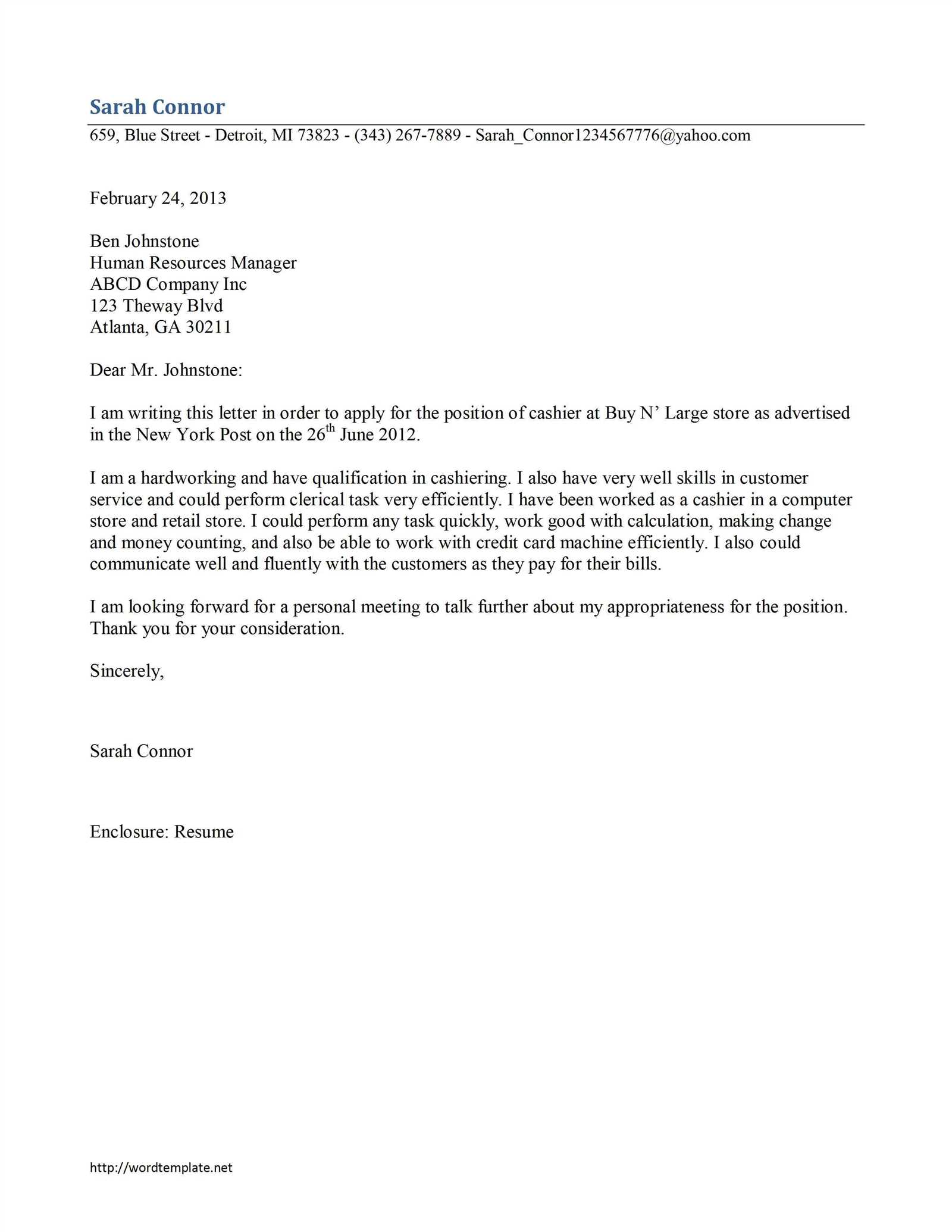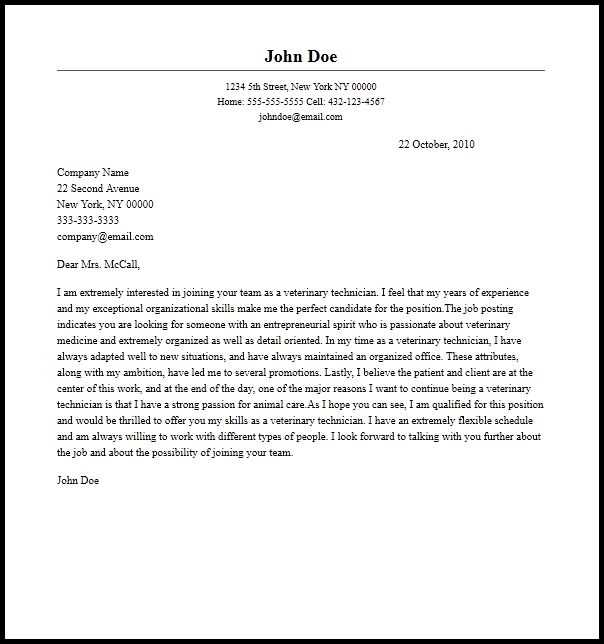Technician cover letter template

Focus on clarity and precision when writing your technician cover letter. Highlight your specific skills, technical experience, and problem-solving abilities that are directly relevant to the job. Start by stating your enthusiasm for the position and briefly explaining how your background aligns with the company’s needs.
In the first paragraph, mention your technical expertise and any certifications you hold. Refer to specific tools or technologies you’ve mastered that are important to the role. This makes it easier for hiring managers to immediately see how you can contribute to their team.
In the next section, showcase a few key achievements or situations where you effectively solved complex issues. Be concise but specific about how you applied your skills to improve efficiency or resolve technical challenges in previous positions. This reinforces your value as a technician who can tackle real-world problems.
Wrap up your letter with a brief, confident statement about your eagerness to bring your technical abilities to the company. End by thanking the reader for their time and expressing interest in discussing how you can contribute to their team further.
Technician Cover Letter Template
Focus on highlighting your hands-on skills and technical expertise right from the start. A well-structured technician cover letter should directly address the job requirements and match them with your specific experience.
- Opening paragraph: Start with a brief statement on why you’re applying, referencing the company and position. Mention how your background aligns with their needs.
- Skills and qualifications: Use this section to focus on key technical skills you possess. Be specific: “I have over five years of experience in diagnosing and repairing electronic systems” or “Proficient in using diagnostic tools such as XYZ.” This is where you sell your technical capabilities.
- Experience: Highlight relevant experience. Emphasize how your past roles involved similar duties or challenges. Mention any measurable outcomes, like improving repair times or reducing customer complaints.
- Soft skills: While technical expertise is crucial, don’t forget to mention your problem-solving, communication, and teamwork abilities. Mention how you collaborated with other teams or handled customer interactions effectively.
- Closing: Conclude with a call to action, like expressing your interest in discussing the role further. Include your contact information and availability for an interview.
Keep your cover letter focused, specific, and concise to make an impact. Avoid overloading it with unnecessary details or generic statements. Tailor each letter to the position, and don’t forget to proofread before sending!
Crafting the Perfect Opening Statement
Be specific and direct. Open with a strong, clear statement about your motivation for applying. Highlight how your technical expertise aligns with the job at hand. A straightforward introduction can make a lasting impression and immediately demonstrate your suitability.
Show your enthusiasm. Convey genuine interest in the company or role, but avoid sounding generic. Focus on a specific aspect of the company or job that excites you and relate it to your skills. Personalizing this part of your cover letter shows you’re invested in the opportunity.
Set the tone for the rest of the letter. Your opening should hint at what makes you unique without diving into too much detail. Keep it concise but impactful. Leave the reader wanting to know more about how your experience directly benefits their needs.
Highlighting Your Technical Skills

Focus on specific technical abilities relevant to the role. Mention your proficiency in software, programming languages, hardware troubleshooting, or systems maintenance, depending on the position you’re applying for. Instead of listing general skills, provide examples of projects where you applied these abilities. For instance, describe a scenario where you optimized a system’s performance or resolved a complex issue, detailing the tools and processes used. This approach gives hiring managers a clear understanding of your practical expertise and problem-solving capabilities.
Link your skills to measurable outcomes. Whether it’s reducing downtime, improving workflow efficiency, or increasing system security, showing how your technical expertise contributed to tangible results will make a stronger impact. Highlight certifications or specific training programs you’ve completed that demonstrate your commitment to maintaining and enhancing your skills.
Tailor your skillset to match the job description. Avoid listing skills that don’t directly apply to the position. For example, if the role requires experience with certain software or tools, prioritize those skills. If you’ve worked in a variety of technical environments, emphasize your adaptability and ability to quickly learn new systems.
Demonstrating Industry Knowledge and Experience
Showcase your hands-on experience with concrete examples of past projects. Focus on specific tasks, technologies, and challenges you’ve successfully handled in previous roles. For instance, highlight how you implemented a specific system or solved a particular issue that directly benefited the company or client. Mention the tools or methods you used, demonstrating familiarity with the industry standards.
Be direct about your expertise in key areas. If you’ve worked with particular software or machinery, specify which ones and the extent of your involvement. Highlight any certifications or training that add credibility to your qualifications.
Discuss your understanding of industry trends and how you’ve applied this knowledge in practice. For example, if you worked on integrating a new technology, explain how it impacted operations and what steps you took to ensure successful implementation.
Don’t just list your achievements; show the impact of your work. Quantify results wherever possible. For example, mention how you improved efficiency by a specific percentage or how your problem-solving skills contributed to meeting project deadlines ahead of schedule.
Finally, tie your experience back to the company’s needs. Demonstrate how your background makes you an ideal candidate to help them solve their specific challenges or achieve their goals.
Tailoring the Letter for Specific Job Roles
To increase the chance of getting noticed, customize each cover letter for the particular role you’re applying for. Highlight skills and experiences directly related to the job description, and use the company’s terminology to show you understand their needs.
Research the Job Requirements
Carefully analyze the job posting. Identify key responsibilities and qualifications, and match them to your own experiences. If the role emphasizes technical skills, mention your proficiency in relevant tools and software. If it’s more customer-focused, highlight your communication or problem-solving abilities.
- Study the job description carefully to pick out specific skills or qualifications.
- Use the same wording from the listing to demonstrate your alignment with their needs.
- Provide examples of how you’ve used those skills in past positions.
Customize the Opening Paragraph
Tailor your introduction to each specific job. State why you’re excited about the opportunity and what draws you to this role in particular. Avoid using generic phrases like “I’m applying for this position because I am qualified.” Instead, show enthusiasm and focus on how your experience aligns with the company’s goals.
- Introduce your most relevant skills right away.
- Show understanding of the company and its mission.
- Be concise but specific about why you’re a perfect fit for the role.
Structuring the Body for Maximum Impact
Focus on clear, concise statements that highlight your relevant skills. Begin with a strong opening sentence that showcases your most important qualifications. Provide specific examples of how your expertise can address the company’s needs. Avoid vague claims, and instead demonstrate your skills through tangible achievements.
Tailor Your Experience to the Job
Adjust each paragraph to reflect the job’s requirements. Be precise about your accomplishments, quantifying them where possible. Show how your past work has prepared you to solve the problems the employer faces. Make sure each section flows logically to the next, emphasizing how each skill or experience is connected to the role.
Maintain Focus on the Employer’s Needs

Throughout the body, stay aligned with the company’s goals. Avoid diverging into unrelated details. Think about what the employer values most, and make sure your experience aligns with their priorities. Each paragraph should work toward illustrating your potential to contribute effectively to their team.
Closing the Letter with a Strong Call to Action
Finish your cover letter with a clear and direct call to action. Express your enthusiasm for the position and show how you can contribute to the team. Invite the reader to reach out for further discussion or to schedule an interview. Make your intention clear and specific, such as “I would appreciate the opportunity to meet and discuss how my skills can contribute to your team’s success.” This gives a sense of eagerness and professional confidence.
Be Direct, But Polite
Close with a direct yet courteous request. Avoid vague phrases like “looking forward to hearing from you” and opt for something that drives the conversation forward. For example, “Please feel free to contact me at your convenience to arrange a meeting” or “I look forward to your response and the opportunity to discuss my qualifications further.”
Be Ready for the Next Step

Your call to action should encourage the next step, without being pushy. Show that you’re prepared to take immediate action and follow through. Offer flexibility in your availability and show that you’re confident in your qualifications.
| Effective Call to Action Examples | Why It Works |
|---|---|
| “I look forward to discussing how my experience can contribute to your team.” | Shows readiness and links skills to the employer’s needs. |
| “Please contact me at your earliest convenience to schedule an interview.” | Clear and professional, showing respect for their time. |
| “I am excited to explore the next steps in our conversation.” | Demonstrates enthusiasm and eagerness to proceed. |